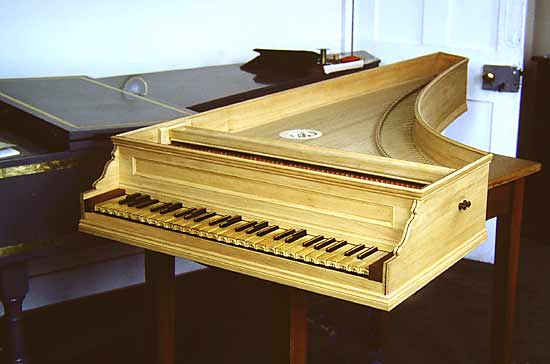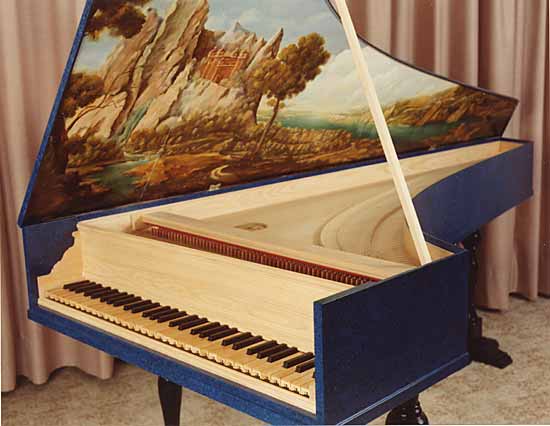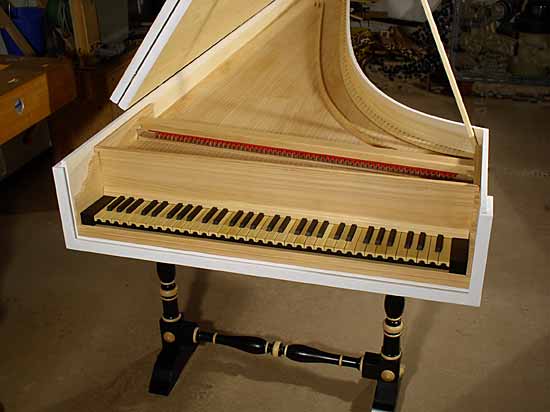FLORENTINE HARPSICHORDS
One of the major cultural centres in Italy. Those instruments made around 1600 provide evidence of the transition from the older style with C/E-f³ compass to the C/E-c³ range, but no change in pitch was involved. Soundboards were mostly of cypress, but Bolcioni and Querci used both cypress and spruce/fir soundboards. The scales were usually intended for brass stringing, but instruments such as the two-manual harpsichord I have attributed to Migliai (with a faked signature "Domenico da Pesaro", Germanisches Nationalmuseum MIR 1078) appear to have been intended for iron wire and a pitch of 465 Hz. At the beginning of the century Poggi was active as an instrument maker, from whom a few harpsichords have survived and indicate the early Florentine style.
A harpsichord anon. c.1620, C/E-f³, 8'+8' with split sharps.

Hear my replica: ![]()
The anonymous harpsichord in the Russell Collection (now no. 4302) may have been made in Florence or possibly Rome (as I suggested in 1996, PhD, Part 2, p. 327), based on stylistic considerations of the mouldings and casework. As John Barnes established, it originally had the older type of compass, C/E-f³, with split sharps for F# and G#, with d#/eb,
g#/ab, d#'/eb', g#'/ab', d#²/eb². A checklist of Italian instruments with split sharps is available as a download. It has brass stringing with a spruce soundboard. More recently Grant O'Brien attributed its origin to a Neapolitan workshop on the basis of the units of measurement used. However, Darryl Martin in a comprehensive analysis of the design found a Florentine origin to be more likely. (see 'EUCHMI (4302): A Case Study of Harpsichord Identity', Galpin Society Journal LXIII (2010), pp. 17-47.)
A Florentine harpsichord after Querci c.1625, C/E-c³, 8'+8' with split sharps.
This instrument is appropriate for the performance of Frescobaldi's music (Frescobaldi was employed in Florence during 1628-1634) and incorporates split sharps for F# and G', with d#/eb, g#/ab, d#'/eb', g#'/ab', d#²/eb².) There is a faked inscription on the original harpsichord ascribing it to Zenti (Musikinstrumenten-Museum, Leipzig, no. 75), but a clear identification to Querci was possible on the basis of the mouldings. Made as an inner-outer instrument it has brass stringing with a spruce soundboard.
A Florentine harpsichord after Migliai 1695, FF,GG,AA-c³, 8'+8' (Händel-Haus, Halle, MS68).
This harpsichord made in the inner-outer style reflects the work of a Florentine maker who probably influenced Cristofori, rather than the other way round since Migliai was active in Florence before Cristofori arrived from Padua. It has a cypress soundboard, brass stringing, and an unusual split bottom key for FF and GG: a reasonable surmise would be that this was a last minute modification to a GG,AA-c³ design.
The influence of Bartolomeo Cristofori in Italy and Portugal
Cristofori is one of the best known of all instrument makers on account of his invention of the piano action. His work as a harpsichord maker was innovative and influenced other makers, both in Italy and abroad. Giovanni Ferrini worked with him for many years and was his successor, producing both harpsichords and fortepianos, so that Ferrini's instruments are not easily distinguished from Cristofori's. Other makers such as Feroci and Solfanelli obviously knew Cristofori's designs, perhaps as the result of having worked for him. When I was given a commission for an Italian harpsichord with 4' register, yet having a wide compass GG,AA-f³, I used Cristofori's technique of breaking from a brass scale to an iron scale (with separate bridges in the treble) in order to incorporate enough space for the 4' bridge on the soundboard. (These techniques have been described further in 2002, "Some evidence...", see Publications).
A GG,AA-f³ harpsichord made for the University of Ferrara.
Painting by Sylviane Pitour, Strasbourg.
A Florentine harpsichord from the Cristofori-Ferrini workshop,
FF,AA-g³ with 2 x 8'
This instrument is based on Leipzig no. 89 which I attribute to Ferrini's workshop (rather than Cristofori's) and Cristofori's 1722 harpsichord (Leipzig no. 84). It is made in the style "non levatoro di cassa" which we now usually call "false-inner-outer", although the full illusion of an inner instrument in an outer case was not strived for. I have made it in the late workshop style with a double-bentside construction, which Cristofori reported to Maffei (in his 1709 meeting with him) as enabling him to make new instruments sound as good as old ones. The stringing is brass wire and the soundboard is of cypress thereby conferring a characteristic quality of timbre that is not achieved with spruce/fir soundboards. This tone is particularly reedy and well focussed in the tenor and bass area, making the voices even more clearly separated and distinct. Cristofori is not known to have used any soundboard material other than cypress. The pitch is at 415 Hz with a transposing option to 440 Hz.

This harpsichord was made as a pair to the Cristofori fortepiano (seen here in its gesso ground and with a stand borrowed from the fortepiano; the inside of the case above the soundboard is due to be painted with Venetian red pigment, the outside green. The knobs for the transposing keyboard have not yet been fitted).
It is now clear that Cristofori's harpsichords also influenced Portugese harpsichord making. The 1785 Antunes harpsichord was evidently based on a Cristofori design and we may infer that the instruments Cristofori supplied to the court of King João V in Portugal provided a model which native Portugese makers then followed. This is an interesting insight into 18th-century Portugese harpsichord construction since until now we had only seen Cristofori's influence in the new fortepiano, which they also adopted. One of the features they incorporated was the appearance of a Cristofori double-bentside construction even though they only used the normal harpsichord bentside design!